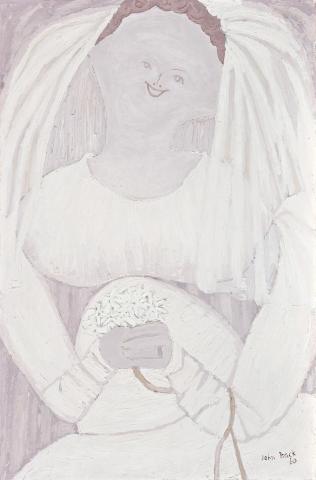THE BRIDE, 1960
JOHN BRACK
FROM THE WEDDING SERIES
oil on composition board
71.0 x 47.0 cm
signed and dated lower right: John Brack / 60
Johnstone Gallery, Brisbane
Private collection, Brisbane
DC Art, Sydney (label attached verso)
Private collection, Sydney
John Brack, Johnstone Gallery, Brisbane, 26 April – 13 May 1960, cat. 6
Langer, G., 'A painter with a taste for satire', Courier-Mail, Brisbane, 26 April 1960
Grishin, S., The Art of John Brack, Oxford University Press, Melbourne, 1990, vol. I, p. 79, vol. II, cat. o107, pp. 16, 114 (illus.)
John Brack's best bridal paintings have an engaging confection about them akin to the icing on wedding cakes - sweet and delicious, the first sight or taste inviting more, with an acerbic slice underneath. The series of nine oil paintings and others on paper received its spark of life, as Robert Lindsay tells us, from Brack's chance discovery 'of an illustration of a wedding cake attached to a toy cake-icing set belonging to one of his daughters. It gave him the solution - to focus away from the celebrants and onto the cake, the symbol of the union.'1 In The Bride, 1960, the confection is the bridal dress itself, the whole picture providing an image of repeated smiles, as that on her happy face echoes throughout the composition. The upturned edges of the mouth, neckline, and ample bosoms are quite infectious, translating, through the curves of the arms, into a warm embrace. The reverse curve hangs above and likewise repeats itself as if to remind us that life is full of ups and downs, to be remembered on the wedding day when commitment is made for better or for worse. Brack's precise handling of form within a limited, subtly modulated palette, speaks of early mastery, the interplay between positive and negative shapes introducing a comic light-heartedness. The latter finds its apotheosis in The Bride and Groom, 1960 (one of the chief works in the series), in the collection of the National Gallery of Australia, Canberra. One senses the figurative play across an abstract base of solid foundation.
The blend of technical exploration and ideas continue in Brack's highly sensual use of impasto creating an almost irresistible desire to touch. Helen Brack wrote of the early 1960s of 'John's experimentation with impasto as a language, not a literal extension of the word "painting" ...'2 Brack's art always sets us on a chase as the mind explores what is offered and draws its conclusions. In this series with the wedding as the subject, Helen continued, he took Rembrandt's great Jewish Bride in the Rijks Museum, Amsterdam, 'as reference, but the impasto language, for him, did not go beyond sensuality'.3 It is wrapped, however, in that satire unique to Brack, a wrapping through which we observe the farcical sides of our ways. Sharp as his vision and execution may be, there is a poignant touch to his vision of the human condition that makes his art all that more powerful.
1. Lindsay, R., John Brack, A Retrospective Exhibition, National Gallery of Victoria, Melbourne, 1987, p. 18
2. Brack, H., 'This Oeuvre - The Work Itself', in Grant, K., with Grishin, S., Lindsay, R., and McAuliffe, C., John Brack, National Gallery of Victoria, Melbourne, 2009, p. 14
3. Ibid.
DAVID THOMAS
